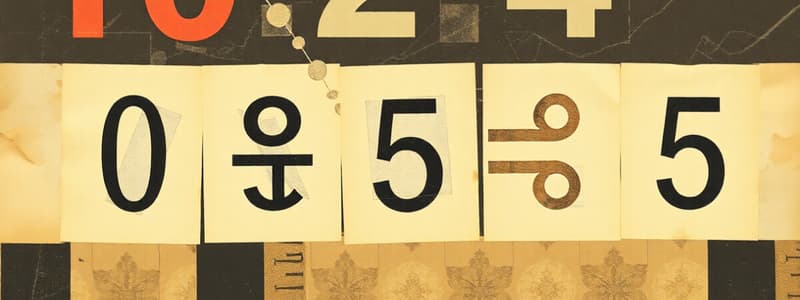Podcast
Questions and Answers
What is the correct order of the integers 5, -100, 125, -111, 0, and 90 from least to greatest?
What is the correct order of the integers 5, -100, 125, -111, 0, and 90 from least to greatest?
- -111, -100, 0, 5, 90, 125 (correct)
- -100, -111, 0, 5, 125, 90
- -100, -111, 5, 0, 90, 125
- -111, -100, 5, 0, 125, 90
What is the result of the addition problem -22 - 6?
What is the result of the addition problem -22 - 6?
- -16
- -32
- -18
- -28 (correct)
When rounding the number 3.769 to the nearest tenth, what is the result?
When rounding the number 3.769 to the nearest tenth, what is the result?
- 4
- 3.7
- 3.6
- 3.8 (correct)
What is the approximate sum when estimating 1497 + 2765?
What is the approximate sum when estimating 1497 + 2765?
What is the result of multiplying 8910 by 462?
What is the result of multiplying 8910 by 462?
In ordering integers, the smallest value among 5, -100, 125, -111, 0, and 90 is ______.
In ordering integers, the smallest value among 5, -100, 125, -111, 0, and 90 is ______.
When adding the integers -13 and 7, the result is ______.
When adding the integers -13 and 7, the result is ______.
The process of adjusting the number 3482 to the nearest power of ten yields ______.
The process of adjusting the number 3482 to the nearest power of ten yields ______.
The result of multiplying 85 and 3 is ______.
The result of multiplying 85 and 3 is ______.
When estimating the sum of 1497 and 2765, rounding both numbers gives approximately ______.
When estimating the sum of 1497 and 2765, rounding both numbers gives approximately ______.
Flashcards are hidden until you start studying
Study Notes
Ordering Integers
- Ordering integers from least to greatest involves understanding the position of numbers on a number line
- Negative numbers are less than zero
- Positive numbers are greater than zero
Adding Integers
- Adding integers with different signs
- Subtract the smaller absolute value from the larger absolute value
- Use the sign of the number with the larger absolute value
Estimating and Rounding
- Rounding numbers to the nearest 10, 100, or 1000 involves identifying the place value and adjusting the number to the nearest value
- Rounding to the nearest tenth involves identifying the tenths place value and adjusting the number to the nearest tenth value.
Multiplication
- Multiplication involves repeated addition.
- For large numbers, multiplication can use a vertical format for easier calculation.
Ordering Integers
- Ordering integers involves arranging them in ascending or descending order based on their values.
- Negative numbers are always smaller than positive numbers.
- Zero is neither positive nor negative.
- Larger negative numbers are smaller than smaller negative numbers.
Adding Integers
- Adding integers involves combining numbers with their respective signs.
- When adding numbers with the same sign, add the absolute values of the numbers and keep the same sign.
- When adding numbers with different signs, subtract the smaller absolute value from the larger absolute value and keep the sign of the number with the larger absolute value.
Rounding Numbers
- Rounding numbers involves approximating a number to the nearest specified place value.
- To round to the nearest ten, look at the ones digit. If the ones digit is 5 or greater, round the tens digit up. If the ones digit is less than 5, keep the tens digit the same.
- Rounding to the nearest hundred follows the same principle, considering the tens digit.
Multiplication
- Multiplication involves repeated addition.
- Multiplying two numbers involves finding the product of their values.
- To multiply two numbers, multiply their absolute values and then apply the sign rules.
- If both numbers have the same sign, the product is positive.
- If the numbers have different signs, the product is negative.
Studying That Suits You
Use AI to generate personalized quizzes and flashcards to suit your learning preferences.




